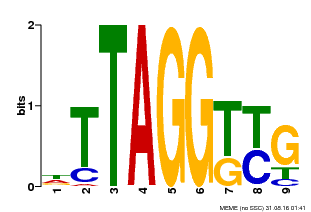 |
PlantRegMap/PlantTFDB v5.0
Plant Transcription
Factor Database
|
| Home TFext BLAST Prediction Download Help About Links PlantRegMap |
Transcription Factor Information
| Basic Information? help Back to Top | |||||||||
|---|---|---|---|---|---|---|---|---|---|
| TF ID | Cucsa.298390.6 | ||||||||
| Common Name | Csa_4G000700, LOC101218411 | ||||||||
| Organism | |||||||||
| Taxonomic ID | |||||||||
| Taxonomic Lineage |
cellular organisms; Eukaryota; Viridiplantae; Streptophyta; Streptophytina; Embryophyta; Tracheophyta; Euphyllophyta; Spermatophyta; Magnoliophyta; Mesangiospermae; eudicotyledons; Gunneridae; Pentapetalae; rosids; fabids; Cucurbitales; Cucurbitaceae; Benincaseae; Cucumis
|
||||||||
| Family | MYB_related | ||||||||
| Protein Properties | Length: 325aa MW: 36187.2 Da PI: 8.1829 | ||||||||
| Description | MYB_related family protein | ||||||||
| Gene Model |
|
||||||||
| Signature Domain? help Back to Top | |||||||
|---|---|---|---|---|---|---|---|
| No. | Domain | Score | E-value | Start | End | HMM Start | HMM End |
| 1 | Myb_DNA-binding | 35.1 | 3e-11 | 5 | 55 | 1 | 46 |
TSSS-HHHHHHHHHHHHHTTTT-HHHHHHHHT.....TTS-HHHHHHHHHH CS
Myb_DNA-binding 1 rgrWTteEdellvdavkqlGggtWktIartmg.....kgRtlkqcksrwqk 46
+++WT eE+ l+ +v ++G g W+tI + R+ ++k++w++
Cucsa.298390.6 5 KQKWTSEEEAALKAGVVKHGAGKWRTILKDPEfssvlYLRSNVDLKDKWRN 55
79***********************************88***********9 PP
| |||||||
| Protein Features ? help Back to Top | ||||||
|---|---|---|---|---|---|---|
| Database | Entry ID | E-value | Start | End | InterPro ID | Description |
| PROSITE profile | PS51294 | 10.594 | 1 | 58 | IPR017930 | Myb domain |
| SuperFamily | SSF46689 | 3.01E-15 | 2 | 70 | IPR009057 | Homeodomain-like |
| SMART | SM00717 | 4.1E-6 | 4 | 59 | IPR001005 | SANT/Myb domain |
| Gene3D | G3DSA:1.10.10.60 | 5.7E-13 | 5 | 56 | IPR009057 | Homeodomain-like |
| Pfam | PF00249 | 1.4E-7 | 5 | 55 | IPR001005 | SANT/Myb domain |
| CDD | cd11660 | 4.05E-18 | 6 | 56 | No hit | No description |
| SMART | SM00526 | 6.2E-10 | 144 | 210 | IPR005818 | Linker histone H1/H5, domain H15 |
| PROSITE profile | PS51504 | 22.497 | 147 | 215 | IPR005818 | Linker histone H1/H5, domain H15 |
| SuperFamily | SSF46785 | 1.2E-14 | 147 | 220 | IPR011991 | Winged helix-turn-helix DNA-binding domain |
| Gene3D | G3DSA:1.10.10.10 | 1.8E-12 | 151 | 218 | IPR011991 | Winged helix-turn-helix DNA-binding domain |
| Pfam | PF00538 | 2.5E-7 | 152 | 208 | IPR005818 | Linker histone H1/H5, domain H15 |
| Gene Ontology ? help Back to Top | ||||||
|---|---|---|---|---|---|---|
| GO Term | GO Category | GO Description | ||||
| GO:0006334 | Biological Process | nucleosome assembly | ||||
| GO:0006357 | Biological Process | regulation of transcription from RNA polymerase II promoter | ||||
| GO:0009651 | Biological Process | response to salt stress | ||||
| GO:0009723 | Biological Process | response to ethylene | ||||
| GO:0009733 | Biological Process | response to auxin | ||||
| GO:0009737 | Biological Process | response to abscisic acid | ||||
| GO:0009739 | Biological Process | response to gibberellin | ||||
| GO:0009751 | Biological Process | response to salicylic acid | ||||
| GO:0009753 | Biological Process | response to jasmonic acid | ||||
| GO:0046686 | Biological Process | response to cadmium ion | ||||
| GO:0000786 | Cellular Component | nucleosome | ||||
| GO:0005730 | Cellular Component | nucleolus | ||||
| GO:0003691 | Molecular Function | double-stranded telomeric DNA binding | ||||
| GO:0033613 | Molecular Function | activating transcription factor binding | ||||
| GO:0042803 | Molecular Function | protein homodimerization activity | ||||
| GO:0070491 | Molecular Function | repressing transcription factor binding | ||||
| GO:1990841 | Molecular Function | promoter-specific chromatin binding | ||||
| Sequence ? help Back to Top |
|---|
| Protein Sequence Length: 325 aa Download sequence Send to blast |
MGAPKQKWTS EEEAALKAGV VKHGAGKWRT ILKDPEFSSV LYLRSNVDLK DKWRNMSVMA 60 NGWGSREKAR LALKRLHAPR KDENAVGPSV AAQSEDELAE AKSVSLSSDI KQITGPKRSN 120 VRKEEEEEEE EEEEKEVERI ERDARYDCHR LDNLIIEAIT TLREPGGSNK TKITSYIEDQ 180 YWAPPDFKRL LSSKLKFLTA SRKLVKVKRK YRLPSVAASE RRSSMLLLED QQKASVRADK 240 DDMCILAKAQ IDLELAKMRT MTSQEAAAAA ARAVAEAEAA IAEAEEAARE AEAAEADAEA 300 AQSFAEAAMK TLKGRNLPKM MIRV* |
| Functional Description ? help Back to Top | ||||||
|---|---|---|---|---|---|---|
| Source | Description | |||||
| UniProt | Binds preferentially double-stranded telomeric repeats. {ECO:0000269|PubMed:19102728}. | |||||
| Binding Motif ? help Back to Top | |||
|---|---|---|---|
| Motif ID | Method | Source | Motif file |
| MP00607 | ChIP-seq | Transfer from AT1G49950 | Download |

| |||
| Regulation -- PlantRegMap ? help Back to Top | ||||||
|---|---|---|---|---|---|---|
| Source | Upstream Regulator | Target Gene | ||||
| PlantRegMap | Retrieve | Retrieve | ||||
| Annotation -- Nucleotide ? help Back to Top | ||||||
|---|---|---|---|---|---|---|
| Source | Hit ID | E-value | Description | |||
| GenBank | LN681874 | 1e-169 | LN681874.1 Cucumis melo genomic scaffold, anchoredscaffold00031. | |||
| GenBank | LN713261 | 1e-169 | LN713261.1 Cucumis melo genomic chromosome, chr_7. | |||
| Annotation -- Protein ? help Back to Top | |||||||
|---|---|---|---|---|---|---|---|
| Source | Hit ID | E-value | Description | ||||
| Refseq | XP_011652912.1 | 0.0 | PREDICTED: telomere repeat-binding factor 1 isoform X3 | ||||
| Swissprot | Q8VWK4 | 6e-96 | TRB1_ARATH; Telomere repeat-binding factor 1 | ||||
| TrEMBL | A0A0A0KV07 | 0.0 | A0A0A0KV07_CUCSA; Uncharacterized protein | ||||
| STRING | XP_004170732.1 | 0.0 | (Cucumis sativus) | ||||
| Best hit in Arabidopsis thaliana ? help Back to Top | ||||||
|---|---|---|---|---|---|---|
| Hit ID | E-value | Description | ||||
| AT1G49950.3 | 3e-73 | telomere repeat binding factor 1 | ||||
| Link Out ? help Back to Top | |
|---|---|
| Phytozome | Cucsa.298390.6 |
| Entrez Gene | 101218411 |



